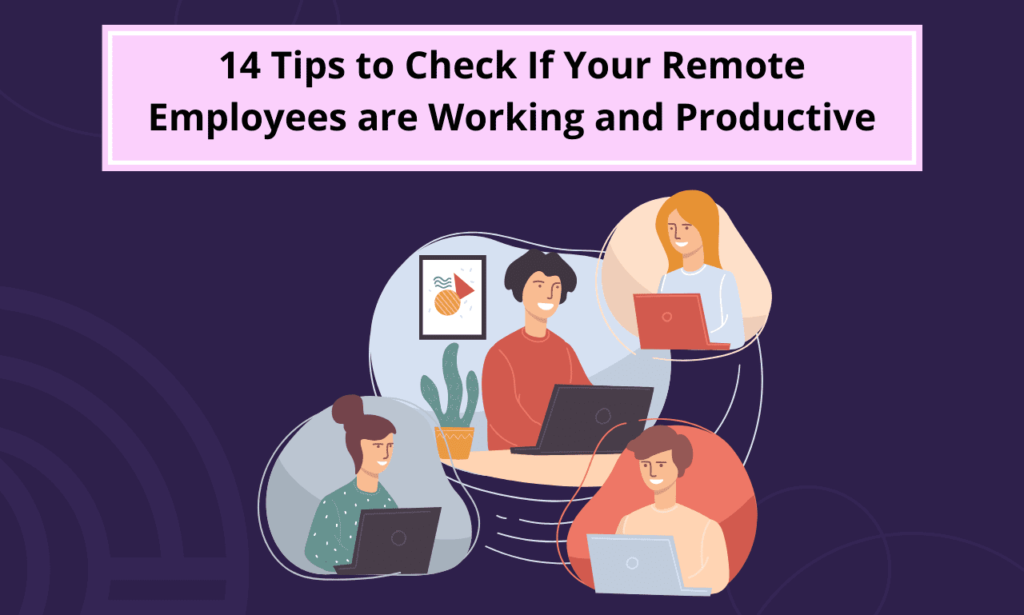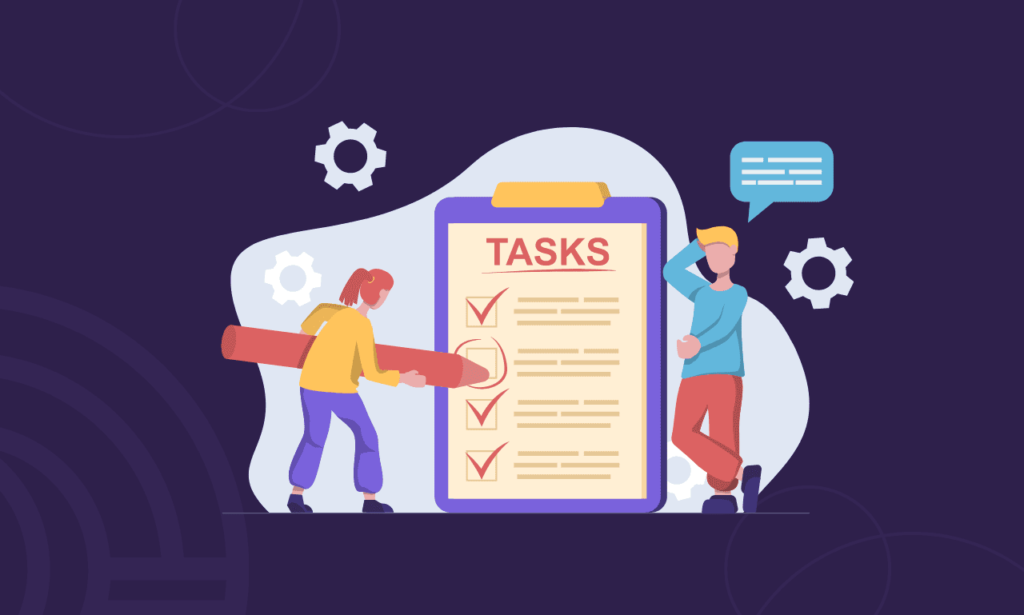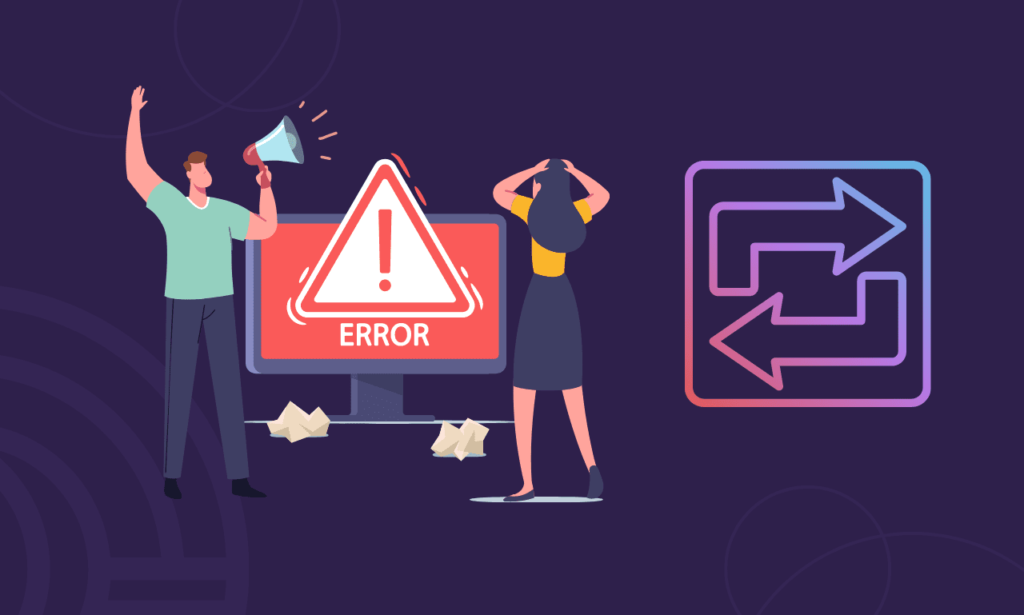14 Tips to Check If Your Remote Employees are Productive


It’s a question that has been on the minds of employers for years now, how can we be sure that our remote employees are working?
It’s not like we can walk into their home office and look around! Luckily, there are some ways to check in on your remote employees and ensure they’re staying productive.
This article talks about how to check if your remote employees are working and how to mitigate the risks.
You can use these 14 tips to help your team work better and produce better results. So, stay tuned and read on to learn all about it!
Remote working definition
Remote working is an arrangement in which employees do not have to be physically present at the office. Employees can work from home, a remote office, or any other location with an internet connection.
Remote employees can stay productive while working remotely

“5 ways to know if your remote employees are actually working: (1) The work is getting done.(2) The work is getting done. (3) The work is getting done.(4) The work is getting done.(5). The work is getting done.” Twist Work.
Working remotely can be a great way to get out of the office and avoid distractions, but staying productive can also be challenging.
Here are a few tips for remote workers who want to stay on task:
Create a dedicated workspace in your home.
The workspace will help you to avoid getting distracted by household chores or other home tasks.
Establish regular work hours
Setting work hours helps you to maintain a healthy work-life balance.
Take breaks
Try to move your body and get some fresh air when you are working. The moving break will help you to stay focused and avoid burnout. Ensure to disconnect from work at the end of the day so you can relax and recharge.
How to check if remote employees are working?
Employers can use remote employee monitoring software to ensure that remote employees are working. This software allows employers to track employee activity, including computer usage, email, and internet browsing.
Additionally, employers can set up alerts to notify them if an employee is inactive for a while. Employers can also use remote teams to check in on employees and provide support as needed.
Using these strategies, employers can effectively monitor remote employees and ensure they are productive.
#1 Checking Email and Phone Status
Employees are your lifeblood, and it’s essential to keep track of their work performance. Checking email and phone status is one easy way to do this.
Employers can check email and phone status to see if everyone is working as expected. And management should know about any issues immediately because they will fix them as soon as possible.
Good communication also allows employees to raise concerns and suggestions about their work. This type of communication allows for a better work environment and faster resolutions to problems.
#2 Use remote desktop tools

Remote desktop tools are a great way to keep an eye on your computer from anywhere in the world. You can use them to check email and phone status, take screenshots, view files, and more.
Remote desktop tools also make it easy for you to access your computer from remote locations, whether you’re at home or work. They won’t have trouble accessing their computers.
#3 Checking Calendar Events
Keeping track of your remote employees can be challenging, especially working from different time zones. To make things easier, check their calendar events on the company website or app.
If any changes occur on their calendar, notify them as soon as possible so they don’t miss work due to unplanned absences.
Additionally, add all your employees’ calendars so you’re always aware of their whereabouts. The quickest way to check if your remote employees are working is to check their calendar events.
#4 Checking Office Hours
It’s important to keep track of your remote employees’ hours so you don’t get too upset. Employers can do this by using remote employee tracking software or keeping an eye on their workspaces.
Disciplining employees may be necessary if they are consistently breaking office hours. Make it clear to them what is expected of them when working remotely, and be sure to set reasonable office hours to avoid any misunderstandings.
Lastly, ensure your remote employees know they are not allowed to check social media, surf the web, or watch TV while working.
#5 Check their attendance online

It is crucial to monitor the employee’s attendance and performance, such as checking their work hours, adjusting office hours, issuing work logs/diaries, reviewing attendance records online, etc.
If there are any concerns about an employee, it is best to address them as soon as possible.
For example, if the employee seems excessively absent, then you might want to change their working hours accordingly or even terminate them from employment altogether.
#6 Track employee hours by phone or computer
It might be difficult and time-consuming to keep track of employee hours. However, various software options make tracking work schedules simpler and more efficient.
For example, phone tracking software can monitor employees’ work schedules in real-time. The software gives you an overview of their whereabouts at any given time and helps manage workloads effectively.
Alternatively, you can input employee hour data into a computer or software program for further analysis. Management needs to keep accurate records of employee hours. Hence, they have all the necessary information to assess worker productivity and handle any unforeseen situations that might arise from time to time.
It’s important to know that your remote employees are working; monitoring their social media profiles can help you track this.
Look for post time (hours and date) in which they have been uploaded and involved. If there are any issues, take action by contacting the employee directly through social media or email.
Additionally, compare the dates of these posts with when they are supposed to have worked and note any discrepancies. This way, you can take appropriate steps to ensure they are working and not just taking a break.
It is important to monitor employee social media activity to ensure compliance with company policies and regulations.
#8 Checking task management software

Keeping track of employee productivity is essential for ensuring the timely completion of tasks and timely delivery of products. A solution to do this is using task management software.
This software helps you track time spent on tasks, employee-to-employee comparisons, and work history tracking. By using email notifications, you can stay updated on their progress and ensure the timely completion of tasks.
Additionally, to check if your remote employees are working, use task management software like Asana or Trello. This software will help you track employee work history, assign tasks, and monitor progress.
Get more out of your business
Get the best employee engagement content every week via mailing list
#9 Time tracking
Time tracking is a proper tool for improving productivity in the workplace. Using task management software, you can track employee time and monitor their work on specific tasks.
The employer can use this information to improve teamwork and manage projects and deadlines.
#10 Checking company chat rooms and forums
One way is to send a quick ping or email to see if anything has changed since their last update. If you don’t see any activity from them, likely, they’re not logged in and working.
If these methods fail, you may need to call them to work for a meeting! But don’t worry, monitoring your remote employees isn’t as difficult as it seems. Just make sure to check company chat rooms and forums regularly to make sure that everything is running smoothly.
#11 Checking Slack Channels

It’s essential to ensure that your remote employees are working as intended. One way to do this is by checking their Slack channels.
This messaging platform can be a great way to keep track of employee status and performance. If there’s no response from the remote employee’s Slack channel, it might indicate that they’re not currently working.
You may want to contact them by phone or email.
Schedule regular job reviews with a manager or HR representative to ensure the employee works from home. Keep in mind that if there’s no response from channels or email, it might be time to investigate the situation further.
Another way you can monitor employee performance is by monitoring their timestamps. Checking this will help ensure that work gets done on time and without any issues.
#12 Looking for Placed Reports
In addition to using placed reports, set up clear and concise communication guidelines. The guidelines help team members know what to do to communicate effectively.
Use this information to determine whether or not your employees are working from home or remote. If they’re not, take measures to correct the situation.
For example, ensure work-from-home policies are properly enforced and consider remote work arrangements only if they are truly necessary.
#13 Checking time tracking software
You can better manage their work and track their progress using time tracking software to check employee time.
Make sure to find the right software for your business and select an option that suits your needs. Once you’ve decided, set up a timer and record employee activities.
Review the logs to ensure they’re accurate and identify any issues needing attention. Time tracking software options include desktop software, online software, and software that works with smartphones.
#14 Sending Push Notifications

Employers should ensure that their remote employees are working and receiving the appropriate notifications. Ensure that the alerts are working by checking their settings.
To send push notifications, you must register your employees’ devices and make sure they have the app installed.
Finally, ensure your remote employees know the importance of push notifications and have the app installed on their devices. Doing this ensures they always work in sync with the rest of the team.
Remote work policy that works for everyone

A remote work policy can be a great way to promote employee flexibility and work-life balance. However, ensuring that the policy is fair and works for everyone is important. Here are a few things to keep in mind when creating a remote work policy:
Define job function for remote workers
Consider the types of work that employees can do from a distance.
Knowing what can and cannot be accomplished from home is crucial.
By understanding the different risks associated with working remotely, you can make the right decision about whether or not to do it.
Clear expectation
Establish clear expectations and guidelines for remote workers. For example, how often should they check in with their supervisor?
Use communication methods that will be effective for the situation. Some methods that may be effective are discussing ideas, brainstorming, and group work.
Request Time off
Ensure a process is in place for remote workers to request time off or make other changes to their schedule. The flexibility avoids confusion and frustration down the road.
Considering these factors, you can create a remote work policy that works well for employees and employers.
Communicating with remote employees effectively

Employers and employees must be clear on what is expected from each other. This way, everyone knows what to do, and there are no misunderstandings. A remote employee handbook can help with this, as can regular check-ins with the employer.
Employers should also ensure they have the right tools to help remote employees stay connected and productive. A remote employee tracking tool can help with this, as well as a chat or video conferencing tool.
Regular communication and check-ins are key to ensuring remote employees stay on track. By doing this, employers can ensure that their remote employees are productive and working effectively.
Frequently Asked Questions
What are some common signs that my remote employees are not working?

Some common signs that remote employees are not working include no activity on their work screens, long idle periods, and repeated failures to connect to the company network.
What should I do if my remote employee is not meeting their goals?
If you have determined that the remote employee is not meeting their goals, look at their work screen to see what might prevent them from achieving results. Once you have identified the issue, take action accordingly.
Conclusion
Now that you know a few ways to ensure your remote employees are productive, it’s time to implement them. Evaluate your team and their individual needs, then start tweaking things until you find what works best for everyone. And don’t forget to remember the importance of communication and collaboration.
Remote employees will succeed by bringing the tools they need to stay connected to you and their team members. With these efforts, you can create a remote work environment that’s productive and enjoyable for everyone involved.


